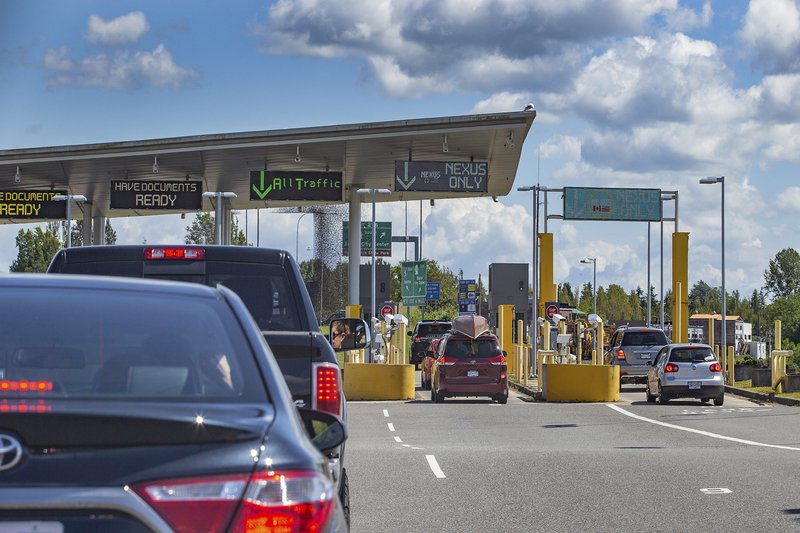
By Nicholas Keung
Sept. 27, 2020
Since March, it’s been all about Fortress Canada.
Amid the COVID-19 pandemic, our ports of entry have been restricted. Travellers from other countries have been largely barred. Many international students and migrant workers have been kept away. Loved ones have been split by the border. Even asylum seekers have been shut out.
But some say the time will come to change that.

Many experts argue Canada cannot continue to keep its doors shut to the world and wait for an effective coronavirus vaccine to be universally available, something some have speculated may not happen until 2024.
How might Canada reopen to travellers? How could it be done — incrementally and safely?
“We cannot maintain blanket border restrictions indefinitely,” says Dr. Vivek Goel, an expert on the federal COVID-19 Immunity Task Force and adviser for CanCOVID, the national research network for the coronavirus.
“That really takes us to: ‘How do we approach reopening in a safe way while maintaining all the work that’s been done within our country, so we don’t re-introduce infections?’”
Before assessing how Canada might ease its border restrictions, it’s probably worth asking the question of whether the closures have worked.
That question turns out not to be so simple.
“When you look at the science around border closures, the evidence is not very thick, because we haven’t had that experience with border closures and pandemics,” says Steven Hoffman, director of the Global Strategy Lab and a professor of global health, law and political science at York University.
“It might very well work, but we just don’t have yet research that shows it.”
When news first emerged in January and February about a highly contagious virus emerging in China, countries including Canada followed the World Health Organization guidelines and kept the border open, relying on health screenings at entry points.
In March, when COVID-19 was declared a global pandemic, Prime Minister Justin Trudeau immediately called on all Canadians abroad to return home before travel restrictions were imposed, so the country could focus on controlling the spread of the virus within its border.
With some exceptions granted, non-essential travel was banned and incoming visitors have been subjected to a health questionnaire and mandatory 14-day quarantine.
A recent paper published by Hoffman and University of Ottawa professor Patrick Fafard found 18 countries had mandated quarantines as of March 18 for incoming travellers from high-risk regions such as China, while 55 countries had banned travel from high-risk regions and 37 countries had enacted total border closures.
Two months later, 14 countries had quarantines for travellers from high-risk regions, 29 countries had bans against travel from these regions and 113 countries had total border closures.
There have been a range of health measures adopted in most countries — social distancing, frequent washing hand and face mask wearing — making it almost impossible to pinpoint how well the border measures in and of themselves are working.
“We’ve seen deference to government, scientists and lawyers around what makes the most sense,” Hoffman says.
“Of course, we should be deferring to the science and the law, but border measures are based on so much more than science and law. Ultimately, actions taken at the border are political.”
Public polls have consistently shown Canadians’ overwhelming support for border restrictions especially at the land ports of entry with our nearest neighbour, the United States, where more than seven million Americans have contracted the virus and about 203,000 have died.
The Public Health Agency of Canada stands by the decision to keep Canada closed.
“Epidemiological evidence has demonstrated that further to those border measures, imported cases of COVID-19 dropped precipitously, from 3,840 confirmed and probable cases in March to an average of 175 per month over the subsequent months,” the agency’s spokesperson, Tammy Jarbeau, says in an email.
“Other countries have similarly demonstrated significant reductions in importation of cases further to imposition of quarantine measures.”
Canada’s new COVID-19 cases have predominantly been spread through community transmission, as officials appear to have a good handle on detecting and tracking imported cases, despite incidents of Americans violating quarantine rules driving to Alaska via Canada and flights flagged for possible exposure to the virus.
“People think the travel restrictions are a panacea for this issue,” says Kelley Lee, a Simon Fraser University public health professor and the Canada research chair in global health governance.
“(They think) ‘If we just close the border, everything will be fine.’ Of course, that’s not the case. And they become complacent.”
Lee is part of an international research team that’s studying how various restrictions are working to combat COVID-19 in hopes of developing a tool to guide international border policies during a pandemic.
“We have to make people aware that border restrictions are just one set of measures. … It’s not like somehow you just shut your border and the pandemic is going to go away,” she says.
There are other possibilities — some more practical than others.

Canada could reopen its border to travellers from countries where the spread of coronavirus is under control.
The federal government could set up a travel pre-authorization system to assess the risks of COVID-19 that a visitor presents before deciding to let them in the proverbial door.
Or Canada could, theoretically, lift travel restrictions to all, but quarantine everyone who arrives in this country for 14 days in government facilities.
There are different examples of travel restrictions for the federal government to draw on.
Since July, the EU has lifted its border restrictions against non-essential travellers from more than a dozen “safe countries” outside of the union, including Canada, that have low infection rates and robust containment measures in place. Countries within the union and the U.K. have peaked again in September and restrictions are being re-imposed.
Places such as Australia, Hong Kong, Singapore and Taiwan have imposed strict government quarantines and tracing measures on incoming travellers.
And within Canada, two months ago, the Atlantic provinces formed a travel “bubble” to restart traffic between New Brunswick, Newfoundland and Labrador, Nova Scotia and Prince Edward Island, following months of regional restrictions to stop the spread of COVID-19. Case counts have remained low throughout the region.
“When you think of travel restrictions, it’s a class of measures trying to stop people from moving and then transmitting a virus. It ranges from us remaining in our homes to people moving from country to country,” says Lee.
“We have different scales of movement and distance. These are similar measures. We are just trying to get people to stay away from one another.”
All measures have their pros and cons.
Holding arriving travellers in designated facilities under government watch is expensive and would be a logistical nightmare.
People can game GPS locators by leaving their cellphones at their supposed quarantine venue.
Safe travel bubbles are based on shared public health practices and compatible infection rates of participating jurisdictions. They won’t work, for instance, if a country is simultaneously open to both high-risk travellers from the U.S. and visitors from low-risk Canada.
And country conditions can also evolve quickly.
In August, thousands of British holidaymakers in Croatia were caught in a rush to return home to avoid a 14-day quarantine after the Balkan state was suddenly removed from the UK government’s travel corridor list.
Since the beginning of September, Goel and McMaster University microbiologist Marek Smieja have started a study at Toronto’s Pearson International Airport. Passengers volunteer to self-swab and are provided with two test kits to repeat on Day 7 and 14 after their arrival, while in quarantine. Participants’ samples are picked up by couriers and tests are done at St. Joseph’s hospital in Hamilton.
Participants are asked about their quarantine condition and public health protocols. A risk assessment is conducted based on where they’re coming from and what activities they have planned while in Canada. For instance, a traveller who stays with a relative or only remains in a conference centre throughout their visit is considered lower risk than someone who will make multiple stops across the country.
The study hopes to enrol 16,000 international travellers by early October, with final results available by the end of November to help guide the federal government on what to do with its travel restrictions.
The goal of the study is to develop a pre-travel assessment and authorization scheme based on the level of COVID-19 risk someone presents.
The customized assessment result would then determine the duration of the quarantine, if any. Those considered low risk could be exempted from a 14-day self-isolation, which hinders the travel plan for people who only have a week-long vacation or need to be here for just a three-day business conference.
“Our view is to start to prepare for this longer period of what could be several years as the vaccine is being rolled out, so the outbreak may be under control but people will still want to have some reassurance about the travellers that are coming in. So we can get tourism and other industries going again,” Goel says.
“Overall, about 10 per cent of the global economy is connected to travel and tourism. It’s not just the airlines and cruise lines. It’s the hotels, taxis and restaurants.”
However, there are risks involved in any measure: Quick self-swab tests may not be as accurate and risks posed by travellers from the same source country can vary.
To relax the travel restrictions and reopen the border, Canada will first need to have its own outbreak under control with a steadily low infection rate. It also needs to ramp up its capacity for testing and tracing.
“If we see 15,000 people coming in each day and each needs two tests, it’s already going to hit Ontario’s daily (COVID-19) testing capacity,” says Goel. “Our capacity needs to be many times than what’s currently available.”
Lee says the terms “border closure” and “travel bans” are misleading because it is not a binary choice like a door that opens or shuts.
“If you are to lift the restrictions, you need to put other things in place,” she notes. “You have to be able to detect those new cases that come in and get them to comply with the quarantine. There are options, but a lot of it comes down to the other measures within the border measures.”
Canada’s approach for inbound travel restrictions has not been country specific but rather based on purpose of travel (whether it’s essential or not).
The Public Health Agency of Canada said it is continually assessing travel risks for Canadians and will adjust and adapt its border measures based on science and evidence.
“As public health pre-requisites are met, Canada will consider a gradual, targeted easing of border measures,” said Jarbeau.


